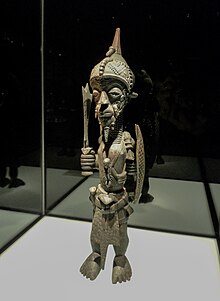The earliest known human settlements in what is now the Democratic Republic of the Congo have been dated back to the Middle Stone Age, approximately 90,000 years ago. The first real states, such as the Kongo, the Lunda, the Luba and Kuba, appeared south of the equatorial forest on the savannah from the 14th century onwards.
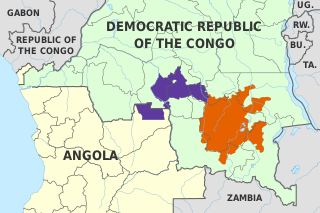
Luba-Kasai, also known as Cilubà or Tshilubà, Luba-Lulua, is a Bantu language of Central Africa and a national language of the Democratic Republic of the Congo, alongside Lingala, Swahili, and Kikongo ya leta.
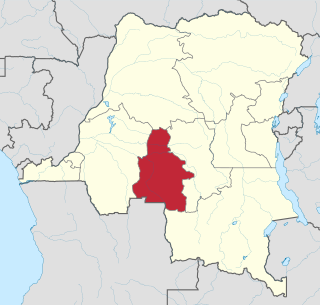
Kasaï-Occidental was one of the eleven provinces of the Democratic Republic of the Congo between 1966 and 2015, when it was split into the Kasaï-Central and the Kasaï provinces.
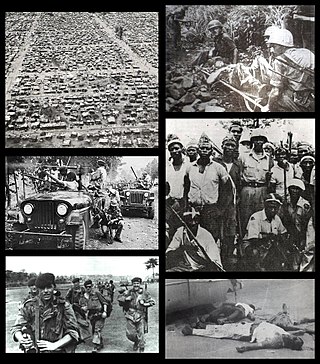
The Congo Crisis was a period of political upheaval and conflict between 1960 and 1965 in the Republic of the Congo. The crisis began almost immediately after the Congo became independent from Belgium and ended, unofficially, with the entire country under the rule of Joseph-Désiré Mobutu. Constituting a series of civil wars, the Congo Crisis was also a proxy conflict in the Cold War, in which the Soviet Union and the United States supported opposing factions. Around 100,000 people are believed to have been killed during the crisis.
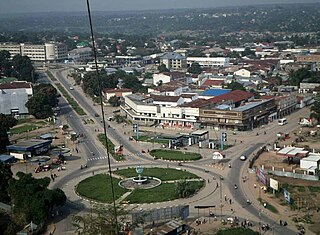
Kananga, formerly known as Luluabourg or Luluaburg, is the capital city of the Kasai-Central Province in the Democratic Republic of the Congo and was the capital of the former Kasaï-Occidental Province. It is the fourth most populous urban area in the country, with an estimated population of 1,524,000 in 2021.

South Kasai was an unrecognised secessionist state within the Republic of the Congo which was semi-independent between 1960 and 1962. Initially proposed as only a province, South Kasai sought full autonomy in similar circumstances to the much larger neighbouring state of Katanga, to its south, during the political turmoil arising from the independence of the Belgian Congo known as the Congo Crisis. Unlike Katanga, however, South Kasai did not explicitly declare full independence from the Republic of the Congo or reject Congolese sovereignty.

The Luba people or Baluba are an Bantu ethno-linguistic group indigenous to the south-central region of the Democratic Republic of the Congo. The majority of them live in this country, residing mainly in Katanga, Kasaï, Kasaï-Oriental, Kasaï-Central, Lomami and Maniema. The Baluba consist of many sub-groups or clans.
The Missa Luba is a setting of the Latin Mass sung in styles traditional to the Democratic Republic of Congo. It was composed by Father Guido Haazen, a Franciscan friar from Belgium, and originally celebrated, performed, and recorded in 1958 by Les Troubadours du Roi Baudouin, a choir of adults and children from the Congolese town of Kamina in Katanga Province. It would later become the partial basis for a Congolese usage of the Ordinary Form of the Roman Rite Mass, the Zaire Use.

Albert Kalonji Ditunga was a Congolese politician best known as the leader of the short-lived secessionist state of South Kasai (Sud-Kasaï) during the Congo Crisis.
The Roman Catholic Archdiocese of Kananga is the Metropolitan See for the ecclesiastical province of Kananga in the Democratic Republic of the Congo. The episcopal cathedral is the Cathédrale Saint Joseph Mikalayi in Kazumba. The Pro-cathédrale Saint Clément is in Kananga.
This is a history of Katanga Province and the former independent State of Katanga, as well as the history of the region prior to colonization.
This is a history of the Kasai region in the Democratic Republic of Congo and of the political divisions which have occupied it since human settlement began.
The Songye people, sometimes written Songe, are a Bantu ethnic group from the central Democratic Republic of the Congo. They speak the Songe language. They inhabit a vast territory between the Sankuru/Lulibash river in the west and the Lualaba River in the east. Many Songye villages can be found in present-day East Kasai province, parts of Katanga and Kivu Province. The people of Songye are divided into thirty-four conglomerate societies; each society is led by a single chief with a Judiciary Council of elders and nobles (bilolo). Smaller kingdoms east of the Lomami River refer to themselves as Songye, other kingdoms in the west, refer to themselves as Kalebwe, Eki, Ilande, Bala, Chofwe, Sanga and Tempa. As a society, the people of Songye are mainly known as a farming community; they do, however, take part in hunting and trading with other neighboring communities.
The Confederation of Tribal Associations of Katanga was one of the main political parties in the Belgian Congo and was led by the pro-Western regionalist Moïse Tshombe and his interior minister, Godefroid Munongo. It became the ruling party of the State of Katanga whose declaration of independence sparked the Congo Crisis.

The indigenous people within the kasai basin up to Maniema understood themselves to be descendants of "AnKutshu Membele", then in the 20th century many accepted the imposed term Tetela . "Batetela" is now understood as an ethnic group of the Democratic Republic of the Congo, most of whom speak the Tetela language.
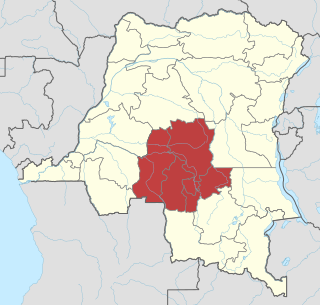
The Kamwina Nsapu rebellion, also spelled Kamuina Nsapu rebellion, was an uprising that took place in the Democratic Republic of the Congo between 2016 and 2019. It was instigated by the Kamwina Nsapu militia against state security forces in the provinces of Kasaï-Central, Kasaï, Kasaï-Oriental, Lomami and Sankuru. The fighting began after the militia, led by Kamwina Nsapu, attacked security forces in August 2016.
Emery Wafwana was a Congolese politician. He served as Minister of Interior of Luluabourg Province and was a member of the Chamber of Deputies.
Barthélemy Mukenge Nsumpi Shabantu was a Congolese politician who served as President of Kasaï Province from 11 June 1960 to January 1962 and July to September 1962. He was a president of the Association des Lulua-Frères, a Lulua ethnic syndicate, and a leading member of the Union National Congolaise. Though initially allied with nationalist Patrice Lumumba, he later denounced him and aligned himself with more moderate politicians. Following the division of Kasai Province in late 1962, Mukenge became Minister of Health and Minister of Social Affairs of the new Luluabourg Province. He later served as Governor of Kivu Province and on the Political Bureau of the Mouvement Populaire de la Révolution. He withdrew from politics in 1974 and died in 2018.
In August 1960 troops of the Republic of the Congo attempted to crush the secession of South Kasai by invading the declared state's territory. Though initially militarily successful, the attack faltered under intense international and domestic political scrutiny and the Congolese troops were withdrawn.
Louis de Jaegher was a Belgian colonial administrator. He was governor of Kasaï Province in the Belgian Congo from 1958 to 1960, just before the country became independent as the Republic of the Congo (Léopoldville).
